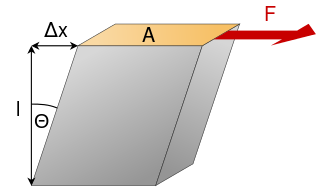Shear Modulus Elastic Moduli - Definition, Difference, FAQs
What is the modulus of rigidity?
Elastic Shear modulus and elastic modulus: Moduli is a unit of modulus of rigidity of measurement for mechanical characteristics of solids. Young's modulus and bulk modulus are two other types of elastic moduli. Allow us to assist you in comprehending shear modulus and elastic modulus. The modulus of rigidity is also known as the shear modulus and elastic modulus of elasticity. Shear modulus and elastic modulus, also known as Modulus of rigidity, is the ratio of shear stress to shear strain. G is frequently used, but S or μ can also be used.
What are elastic moduli?
Elastic Moduli: An external force or load is necessary to modify the form or size of a body. Different materials with the same cross-section and length will deform differently when subjected to the same force. Knowledge of elastic properties of materials such as modulus of rigidity of steel, concrete, and others is crucial when constructing a structure since the elastic behaviour of materials plays an important part in the design. It's also used in the design of bridges, vehicles, ropeways, and other structures. A material with zero shear modulus and elastic modulus is one possible definition of a fluid.
A rigid body is an element with a distinct shape and form. All of the objects and shapes that we see around us are not totally rigid. These shapes can be bent, stretched, or compressed when an external force is applied. These shapes tend to distort when an external force is applied. The internal force that acts per unit area and is applied to restore the previous shape is known as stress. The ratio of the change in dimension caused to the original dimension of the body is characterized as a strain. The modulus of elasticity is the recognized relationship between stress and strain.
Also read -
- NCERT Solutions for Class 11 Physics
- NCERT Solutions for Class 12 Physics
- NCERT Solutions for All Subjects
What is Shear modulus and elastic modulus?
One of the measures of solids' mechanical properties is the shear modulus and elastic modulus of elasticity. Young's modulus and bulk modulus are two more elastomeric moduli.

A shear modulus and elastic modulus is used to describe a tiny deformation of a material caused by adding less shearing force and the ability of the material to restore to its previous state. However, the enormous sharing force is not suitable since it causes permanent deformations in the object.
|
Related Topics, |
- The dimensional modulus of rigidity formula for Shear modulus and elastic modulus is $M^1 L^{-1} T^{-2}$
- The sign G is used to represent it.
- It can be used to explain how a material resists transverse deformations, but only for tiny deformations that can be reversed. Large shearing pressures induce permanent deformations, which is why this is the case (no longer elastic body).
|
Material
|
values for shear modulus and elastic modulus
(at room temperature) |
| 478.0 | |
| Modulus of rigidity of steel | 79.3 |
| Iron | 52.5 |
| Aluminium | 25.5 |
| Polyethylene | 0.117 |
| Copper | 44.7 |
| Titanium | 41.4 |
| Glass | 26.2 |
| Wood | 4 |
NCERT Physics Notes:
Elastic Constants Relation
Young's Modulus, Bulk Modulus, as well as Shear modulus, and elastic modulus, are special formulations of Hooke's law, which asserts that strain experienced by corresponding stress applied is proportional to that stress in elastic material. As a result, the following equation can be used to represent the relationship between elastic constants:
$2 G(1+\nu)=E=3 K(1-2 \nu)$
Where,
The Shear modulus and elastic modulus are denoted by the letter G.
The Young's Modulus is denoted by the letter E.
The Bulk Modulus is K, while Poisson's Ratio is υ.
Difference between Modulus of rigidity and Modulus of Elasticity
Elasticity Modulus vs. Rigidity Modulus
The modulus of elasticity is defined as forces acting on the surface that are normal to it, whereas the modulus of rigidity is defined as the ratio of forces acting on the surface that are parallel to it laterally. The deformation for the modulus of elasticity is linear, but the deformation for the modulus of rigidity is circular. Only elastic deformations are affected by the modulus of elasticity, whereas non-elastic and elastic deformations are affected by the modulus of rigidity.
The object in the deforming force is either shortened or lengthened, depending on the modulus of elasticity; on the other hand, one of the object's surfaces is displaced relative to another surface, depending on the modulus of rigidity. The modulus of elasticity always exceeds the modulus of rigidity; the only exceptions are "auxetic" materials with negative Poisson's ratios, which are rare.
Also, check-
Frequently Asked Questions (FAQs)
The shear modulus and elastic modulus is a measure of a material's ability to resist transverse deformations and is only useful as an indicator of elastic behaviour for modest deformations after which the material can return to its original shape. Flow and permanent deformation or fractures are caused by large shearing pressures.
The ratio of longitudinal stress and longitudinal strain is known as the modulus of elasticity. Because the strain has no unit, it will be represented by the stress unit. The Pascal is the SI unit for this modulus (Pa).
Aluminium has a modulus of elasticity of 70 GPA, while the modulus of rigidity of steel has a modulus of 190–210 GPA. As a result of its higher Young modulus of elasticity, the modulus of rigidity of steel is more elastic than aluminium. As a result, aluminium has a higher rigidity than the modulus of rigidity of steel and is also more brittle.
Young's modulus, Shear modulus and elastic modulus, and Bulk modulus are the three forms of elastic moduli that exist.